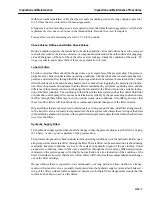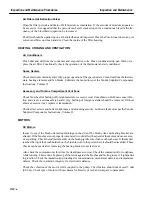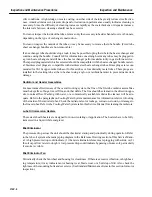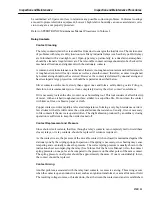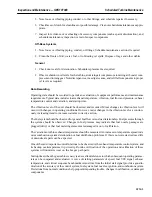
Inspection and Maintenance
Inspection and Maintenance Procedures
IMP–19
5. Malfunctioning combustion system
6. Leakage in external piping
7. Excessive distortion of exhaust inner diffuser
Check wheelspace temperatures very closely on initial startup. If consistently high, and a check of
the external cooling air circuits reveals nothing, it is permissible to increase the size of the cooling
air orifices slightly. Consult with a GE Company field representative to obtain recommendations
as to the size that an orifice should be increased. After a turbine overhaul, all orifices should be
changed back to their original size, assuming that all turbine clearances are returned to normal and
all leakage paths are corrected.
CAUTION
Wheelspace temperatures are read on the <I> CRT. Tem-
peratures in excess of the maximum are potentially harm-
ful to turbine hot-gas-path parts over a prolonged period
of time. Excessive temperatures are annunciated but will
not cause the turbine to trip. High wheelspace temperature
readings must be reported to the GE technical representa-
tive as soon as possible.
FLAME DETECTION AND PROTECTION SYSTEM
Flame Detectors
The flame detection system has two basic functional requirements:
1. It must detect the “presence-of-flame” during startup. A “presence-of-flame” signal is a prerequisite
to continuation of the startup sequence.
2. During operation, the system must detect the “absence-of-flame” to trip the gas turbine. The
“absence-of-flame” signal is very critical to the protection of the gas turbine and of associated
heat-recovery equipment (when furnished).
3. The system is designed to detect the presence of ultraviolet radiation which is emitted by a hydrocar-
bon flame and to provide a signal when the radiation is sensed for a sufficient time period.
The flame detection system is composed of an amplifier and two sensors. The amplifier supplies voltage
to drive the sensors and provides an output logic signal for flame and no-flame conditions. The sensors
respond to ultraviolet radiation from the flame in the combustor and conducts pulses of current. The cur-
rent pulses are integrated at the input on a voltage level detecting and switching amplifier. The resulting
dc voltage signal, proportional to the sensor current is the “flame condition” signal.
Summary of Contents for MS6001B
Page 2: ...Gas Turbine Inspection and Maintenance GEK 107048 I 2 THIS PAGE INTENTIONALLY LEFT BLANK ...
Page 4: ...Inspection and Maintenance Note THIS PAGE INTENTIONALLY LEFT BLANK ...
Page 13: ...INSERT TAB INTRODUCTION ...
Page 14: ......
Page 25: ...INSERT TAB STANDARD PRACTICES ...
Page 26: ......
Page 87: ...INSERT TAB AUXILIARY CONTROLS SYSTEMS MAINTENANCE ...
Page 88: ......
Page 133: ...INSERT TAB SCHEDULED TURBINE MAINTENACE ...
Page 134: ......
Page 157: ...INSERT TAB COMBUSTION INSPECTION ...
Page 158: ......
Page 239: ...INSERT TAB HOT GAS PATH INSPECTION ...
Page 240: ......
Page 313: ...INSERT TAB MAJOR INSPECTION ...
Page 314: ......
Page 316: ...Inspection and Maintenance GEK 107048 Major Inspection 2 THIS PAGE INTENTIONALLY LEFT BLANK ...
Page 363: ...INSERT TAB MAINTENANCE FORMS ...
Page 364: ......

